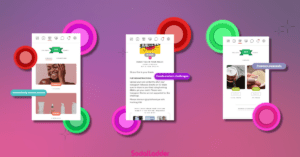
Here’s a number that will get you excited about starting and growing your online community:
On average, online communities generate a 6,469% ROI.
But increasing sales isn’t the only thing that an online community around your brand can achieve. An authentic relationship with your customers can give you valuable insights, increase brand loyalty, drive innovation, improve your brand perception, among many other things.
That’s because the way people choose to support a brand has changed in recent years. Consumers aren’t just looking for the best product only. They gravitate towards brands that share their values and offer a genuine relationship.
But how can you do this for your brand and get a great ROI like the one we mentioned at the beginning of this guide?
These are the 8 steps to launching and growing a successful online community:
- Define your goals
- Think about the user’s needs
- Choose a platform for your online community
- Create community guidelines
- Set up your community
- Promote your online community
- Engage with your online community
- Identify key stakeholders for the online community
In this article, we will take a closer look at each of these steps and share the story of how Trifecta Nutrition was able to build a successful online community, with tips from their VP of Marketing, Tessa Bicard.
Brand Community Building: The Ultimate Guide for 2021
What is an online community?
An online community is a group of people that interact with each other on an online platform. This includes from all the users of a social media platform to a small private group focused on a particular interest.
However, in this article, we will be focusing on building an online brand community. Which we define as a group of engaged customers that have a strong emotional connection to a brand.
With the definitions out of the way, let’s dive into the steps to building an online community.
1. Define your goals
For any marketing strategy, you need to have a clear idea of what you want to achieve first. This is no different for online community building. It might seem to some that building a community is very straightforward. However, planning is crucial because otherwise you will end up with an abandoned, or disengaged, community that gets no real results.
So, try to be specific about your goals. This will help you know what you need to do as a company and what type of content and activities you need to create for your members.
Some goals to consider are building authentic connections, driving awareness, helping users with the product, get feedback, increasing customer satisfaction reviews, increasing sales, etc.
Once you know what you need from your community, it’s time to think about what your community needs from you.
2. Think about the user’s needs
To want to join a community, people need to get something out of it. This is not the place to only be advertised and sold at by the brand. It’s a place where they can build authentic connections with other people with similar interests and with the brand they love.
Typically, people join online communities for one or several of these reasons:
- To learn
- Have a sense of belonging
- Gain exposure
If you think about it, these three motives make a lot of sense. In a community, people want to learn new things, feel like they belong, and tell others about their experiences.
You need to give your customers these things in addition to any other need(s) you identify to build an active online community.
Think about creating content to educate your customers about the topics that interest them. If you offer fitness products, educate about fitness and nutrition, for example. Being a resource and offering continued education to your customers positions your brand as thought leader.
Then, you can show appreciation to your members by having a community spotlight on your social media.
And finally, encourage people to share their experiences in the online platform you chose (more on platforms on the next step).
3. Choose a platform for your online community
Your online community needs a place to gather online. There are various ways you can approach this. The first option is to create a group in an existing social media platform. The most common option is creating a Facebook group.
This is the easiest road since a lot of your customers are already on those social networks and they are easy to use.
The other option is creating your own forum. This forum can be on your website or be a site on its own. An advantage of this method is that you have more control over analytics, data, and members. However, it requires you to promote it more since it’s not part of a popular social media platform and it might be confusing for some people.
Something else to consider is that people create online communities around your brand or niche (fitness, nutrition, entertainment, etc.) by themselves all the time. When these online communities are very active and have a large audience, you can try to add value to them by posting valuable content or answering questions.
When these interactions come from genuine intentions and not for advertising purposes, people appreciate it. These connections you create benefit your brand and grow your own community.
4. Create community guidelines
When managing your community, you will need to provide clear guidelines and some moderation. This is important for any online community because, without it, anyone can do whatever they want and mismanage the community’s expectations for everyone else, usually with spam.
To maintain order and focus, assign someone on your team to moderate the online community and make sure everyone is following the rules.
In a way, communities live and breathe on their own. You just need to provide the guidelines so everyone can have fun.
5. Set up your community
Now that you have everything planned out, it’s time to launch your online community. These are a few things you might need to do at this stage:
- Create your social media platform group or your forum
- Personalize your online community platform to look on-brand
- Create initial pieces of content
- Create welcome emails
- Assign staff to be community managers
- Do some testing
You can also choose to do a soft-launch or hard-launch, depending on your preferences and platform.
6. Promote your online community
Then, you need to let everyone know about your community so people can start joining. These are the best ways to spread awareness of your online community, new or old.
- Email your customer base with information about the benefits of joining the community
- Directly invite top customers
- Promote the community in your website through banners and pop-ups
- Create social media content talking about your community
- Offer exclusive rewards only for community members
- Create a referral program
- Tell your personal and business contacts about your community
Using these methods will help you spread the word and get people interested in joining. But you also need to have in mind that the more active members you have, the more will join. Which means engaging is the best way to promote your online community. This is your next step.
7. Engage with your online community
Engagement is what brings online communities to life. It is also the biggest challenge for community managers. You need to develop strategies that appeal to your audience to encourage more people to participate.
When your community is small and people are not participating, you need to be the one initiating the action. Once members are participating, even if they are just a few, it will create a snowball effect motivating others to interact.
Fortunately, there are some tactics that will almost guarantee engagement. These are a few:
- Get your employees involved in the community
- Create contests that require submitting user generated content
- Directly communicate with your audience – ask and answer questions
- Share people’s stories
- Create exclusive content for your community
- Create a scoring system so that top-contributors get rewarded
- Collaborate with influencers
8. Identify key members in your online community
Once there is some movement in your community, it’s time to identify the most active members. These are the people that spark up the conversations, that really love your brand, and want to see the community grow. They can also be called your advocates.
Naturally, in online communities, most people watch from the sideline. People who just like to look around and interact minimally. By identifying your advocates and appreciating their contributions, you are making the crucial moves to keep the community thriving.
Identifying them should be pretty easy, so after you do so, give them a reward for being a top member of the community. Or you can have a spotlight for the top-contributor of the month.
The idea is that the people who do the most, get the appreciation they deserve.
Your community is one of the best ways to identify advocates and invite them to become ambassadors for your brand. This is another strategy to show appreciation and get authentic promotion from people who truly care about your brand.
Online community example – Trifecta Nutrition

A great example of a brand that through the power of its online community grew impressively is the ultimate personalized, science-backed, organic meal delivery service, Trifecta Nutrition. Which is currently the largest organic meal delivery service in America.
According to their VP of Marketing, Tessa Bicard, focusing on their community has had a very important role in achieving this.
In fact, the #1 tip she would give to other brands looking to drive brand growth is:
“Empower your team, empower your community within, and support each other to feed off each other’s strengths.”
But how is Trifecta able to drive so much growth to their community? Tessa shared some of the methods they use:
- Focus on interacting more with the community
- Grow our Facebook group where our community can be involved and share personal experiences about fitness, nutrition, and wellness
- Ask employees to participate
- Create 1 on 1 connection with our community, whether they are customers or not
- Put a face to the brand to provide authenticity. For example, the VP and CEO engage with our community members personally
- Work to find trends but more importantly, look for anecdotal evidence from the community
- Listen to our customer stories to get feedback and grow the brand
- Extensive influencers and creator programs and looking at these partnerships as more than just transactions. Instead, we partner with these creators and influencers to co-build our brands together
To see how they partner with professional athletes to add real value to their online community, check out the Trifecta app. This expertise attracts new people in the fitness community.
Final thoughts on building an online community
Successful online communities always have the user as the number one priority. To achieve the ROI that we mentioned at the start, you need to forget about it, and make your community worth joining first. Otherwise, the benefits won’t happen.
So build authentic connections, improve your community, add real value to other related communities, and show appreciation to the people that support your brand.


